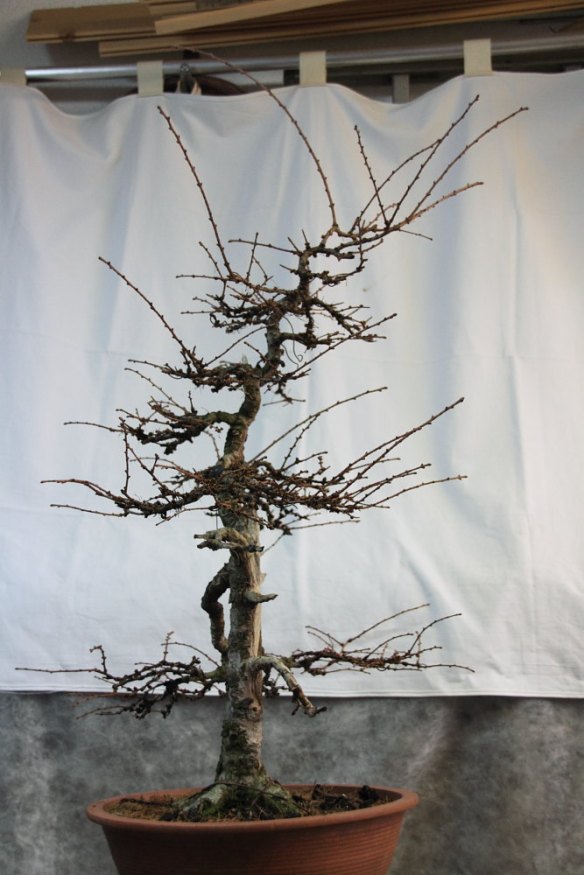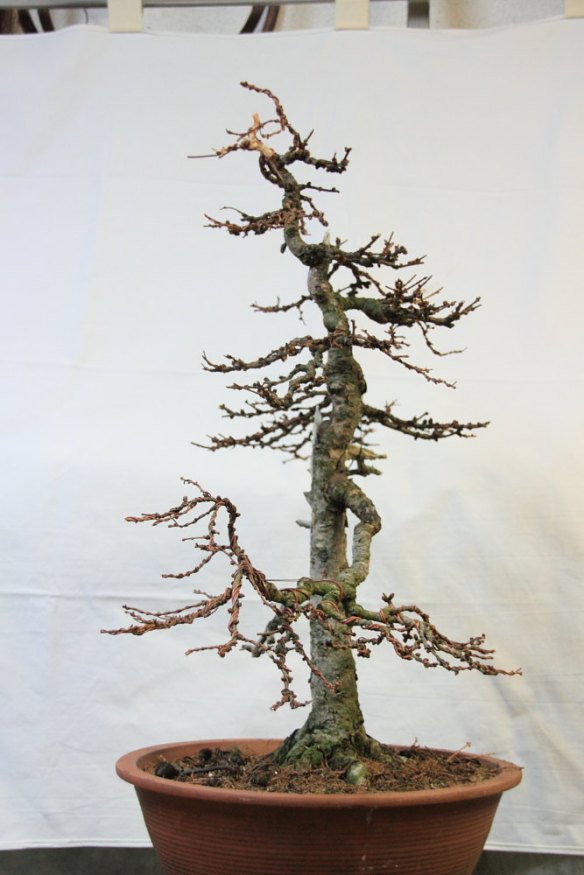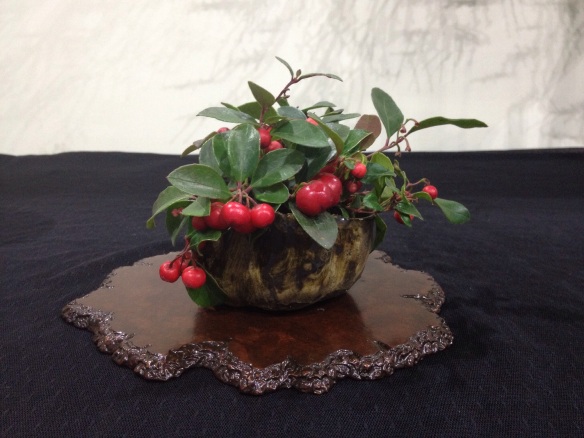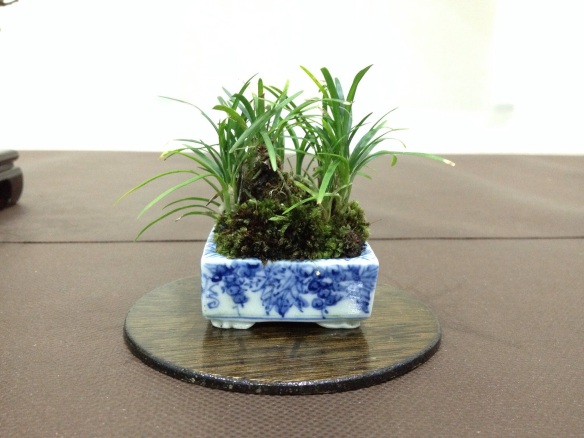Archivio mensile:febbraio 2014
Taikan-Ten 2013, Conifers Part 1
Galleria

Questa galleria contiene 35 immagini.
Originally posted on Nichigo Bonsai:
I’ve been a little slow on processing these images but better late than never. Below is the first half of the conifers from the Taikan-ten. The second half should be along shortly and then we…
Secondo live Trinacria Bonsai Forum: Nicola Crivelli
Larice di Zelinda
Swindon bonsai show 2014
The swindon show has become over the years a real must view bonsai show on the UK bonsai calendar, and while the lighting this year had been replaced in the main hall for crisp white light giving superb conditions. The trees where of a superb quality, while all sizes where on show I was drawn to the shohin trees.

Very nice cork bark elm without as many have the inverse taper.

Another but this one has that classic inverse, but has good ramification.

Hornbeam size wise this is just outside shohin.

This one was interesting, while a nice idea I feel for me it was too large for the pagoda as the framework broke lines of the tree.

This chojubai is a favourite for me for shohin bonsai.

Here are a few of the accents that caught my eye.
View original post 351 altre parole
Mr. Fukunaga’s maples
Here There Be Dragons

A 19th century Japanese map, the Jishin-no-ben, depicting an ouroboros dragon which causes earthquakes.
While the title of this post comes from a phrase on a few older maps depicting uncharted or dangerous territory, there’s no danger here, although maybe there is a little uncharted territory.
Rather than a potter specific post or pots from my collection, today’s article will be the first in a series of articles which will focus on containers from a variety of potters, each with a specific theme, style, or glaze. Today: Dragon Pots!
The history and mythology of Dragons is long and fascinating, a thing that binds all cultures together in our collective mythology. Both the East and the West have mythological histories with dragons, though in the West dragons are almost solely regarded as evil(most likely a medieval link to the book of Revelations which refers to Satan as…
View original post 1.643 altre parole
2014 Winter Silhouette Bonsai Exhibition
The National Bonsai and Penjing Museum, located on the East Coast of the United States, has been having its annual Winter Silhouettes exhibition for nearly 20 years. We’ve recently gone to a biannual show to generate more interest as winter is our slow season at the Arboretum. Japanese Maple-Kiyo-hime, In training since 1946, Donated by Akiko Matsudaira.
Japanese Maple-Kiyo-hime, In training since 1946, Donated by Akiko Matsudaira.
 3 point disaply with Trident Maple, In training since 1895, Donated Prince Takamatsu, Mt. Fuji scroll, and Japanese Blood Grass.
3 point disaply with Trident Maple, In training since 1895, Donated Prince Takamatsu, Mt. Fuji scroll, and Japanese Blood Grass.
 Branch silhouette.
Branch silhouette.
 Japanese Blood Grass, container by MC2.
Japanese Blood Grass, container by MC2.
 Triptych of Root-over-rock Chinese Elms, Donated by Yee Sun-Wu.
Triptych of Root-over-rock Chinese Elms, Donated by Yee Sun-Wu.
 Chinese Hackberry, In training since 1946, Donated by Shu-ying Lu.
Chinese Hackberry, In training since 1946, Donated by Shu-ying Lu.
 Chinese Elm, In training since 1946, Donated by Yee-sun Wu.
Chinese Elm, In training since 1946, Donated by Yee-sun Wu. Bald Cypress, In training since 1972, Donated by Vaughn Banting.
Bald Cypress, In training since 1972, Donated by Vaughn Banting.
 Chinese Elm, In training since 1970, Donated by Marybel Balendonck.
Chinese Elm, In training since 1970, Donated by Marybel Balendonck.
 Year of the Horse shohin display.
Year of the Horse shohin display.
 Rabbit foot fern, container by Lang…
Rabbit foot fern, container by Lang…
View original post 93 altre parole
A visit to Shunka-en
The second stop on our garden tour was to Kunio Kobayashi’s bonsai garden, Shunka-en. Located just outside Tokyo (and a fair drive from Kimura’s garden) it was begun by his father some seventy years ago. The garden was the largest I’d seen that day and very impressive. We were greeted by trees before we ever set foot in the garden–they were even on the roof!
Once inside the gate, we were ushered past familiar, famous old junipers and pines to the indoor Tokonoma display area by our guide, whose name I forgot, but has been an apprentice there for two years now and speaks excellent English.
The first display featured an Ume, or Japanese flowering plum, one of the first trees to flower in early spring:
The next display featured a Japanese black pine with a cascading branch and the elements of display suggesting water as the black pine grows…
View original post 743 altre parole
Boschetto di aceri palmati… “di recupero”
Ottimo lavoro
E’ un po’ che cerco di capire come fare un boschetto che possa essere ‘più giusto possibile’… e così quando capita recupero piante e piantine a destra e a manca oltre che mettere talee un po’ ovunque (vasi ad hoc, vasi di altre piante… e difatti non è così infrequente trovare mie piante con qualche ‘intruso’); i grossi limiti di questa ‘opera di acquisizione’ sono:
- lo spazio necessario per tenere tutti i vasi
- non sempre le piante sono nel medesimo substrato piuttosto che quello con cui sono più abituato… ne consegue che il tutto richiede qualche attenzione in più
- la proporzione delle piante (difficilmente ci sono ‘leader perfetti’… oppure manca i movimento corretto per armonizzare il più possibile la futura composizione…)
- talvolta in specie così belle, ma anche così varie è difficile avere tante piante della stessa varietà.
Il 23 febbraio 2014 ho deciso di ridurre il numero di vasi…
View original post 584 altre parole




















































